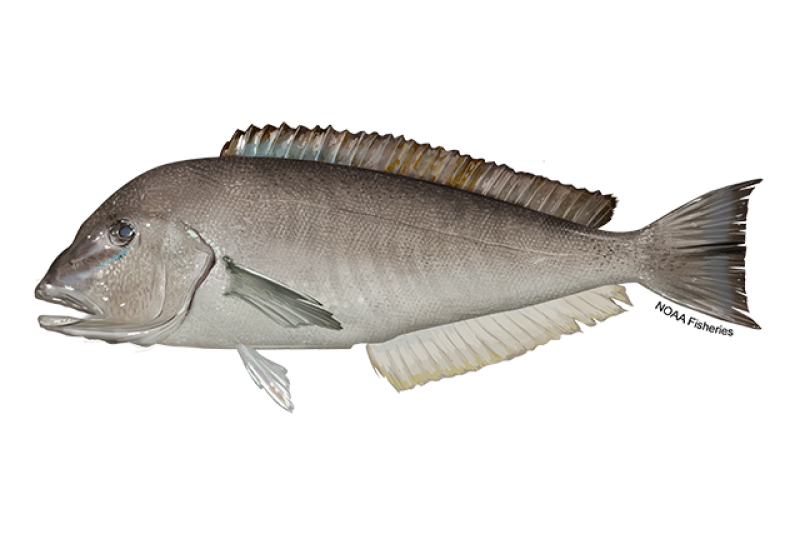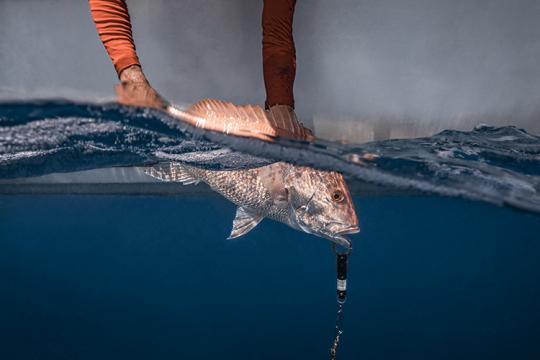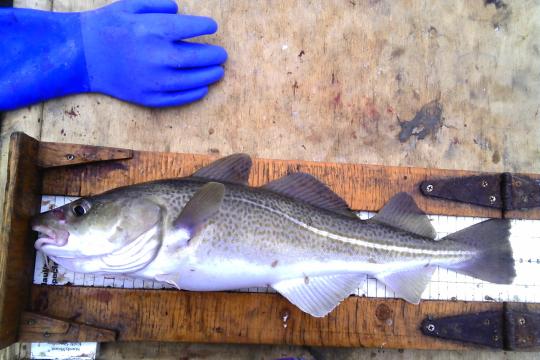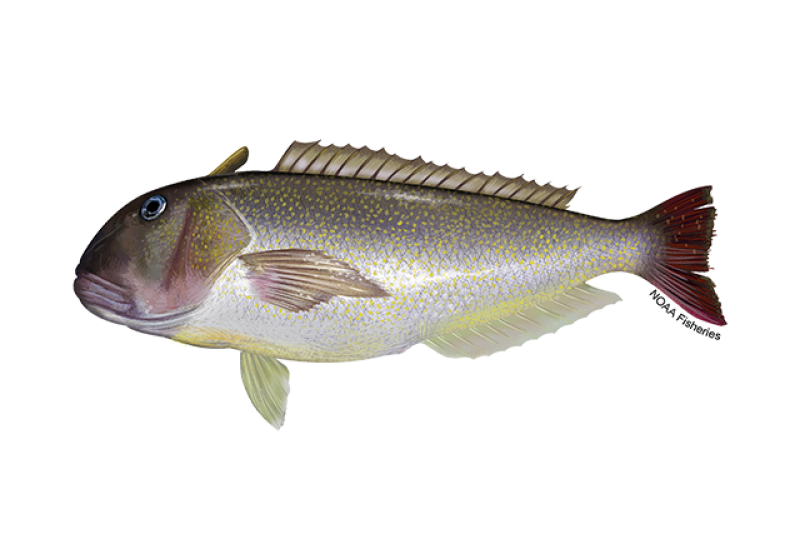Tilefish
About the Species
Tilefish are found Maine to Campeche, Mexico on the outer continental shelves, shelf breaks, and upper slopes. The tilefish fishery in the Greater Atlantic Region of the U.S. is managed from Maine through Virginia, with the majority of the fishery concentrated between Nantucket Island, Massachusetts, south to Cape May, New Jersey; more specifically between Hudson and Veatch Canyons. The commercial fishery predominantly uses longline gear, although handline, rod and reel, and trawl gear are also authorized. The recreational fishery has no gear restrictions, but rod and reel and spear are the most common gears used based on the authorized possession limits. Market data is not yet available for the Mid-Atlantic tilefish fishery north of the VA/NC border. U.S. wild-caught tilefish is a smart seafood choice because it is sustainably managed and responsibly harvested under U.S. regulations. Implementing regulations are found at 50 CFR part 648 subpart N.

Population
In the South Atlantic, not overfished. In the Mid-Atlantic and Gulf of Mexico, the stocks have not been assessed, the population levels are unknown, and management measures are in place.

Fishing Rate
In the South Atlantic and Gulf of Mexico, not subject to overfishing. In the Mid-Atlantic, overfishing status is unknown, but management measures are in place.

Habitat Impacts
Fishing gears used to harvest blueline tilefish have minimal impacts on habitat.

Bycatch
Regulations are in place to minimize bycatch.
Population Status
-
There are three stocks of tilefish: the Mid-Atlantic stock, the South Atlantic stock, and the Gulf of Mexico stock. According to the most recent stock assessments:
-
The Mid-Atlantic stock has not been assessed so the population status is unknown.
-
The South Atlantic stock is not overfished (2017 stock assessment), and is not subject to overfishing based on 2022 catch data. Summary stock assessment information can be found on Stock SMART.
-
The Gulf of Mexico stock is managed as part of the Gulf of Mexico Tilefishes Complex and has not been assessed so the population status is unknown. This complex is not subject to overfishing based on 2022 catch data.
-
Appearance
- Also known as blueline tilefish, they get this name from a narrow gold stripe underlined in blue that runs from their snout to the tip of their eye.
- They have a long snout and are a dull olive-gray on the top of their body and white on the bottom.
- They have long, continuous dorsal and anal fins that are more than half the length of their body.
- Unlike golden tilefish, they do not have a large adipose flap (crest) on their head.
Biology
- Tilefish can grow to be 35 inches long and live up to 26 years.
- Males can grow larger than females.
- Female tilefish mature when they are about 3 years old.
- They can spawn year-round, but peak spawning is in May. Spawning primarily occurs at night.
- Females can lay more than 4 million free-floating eggs.
- Tilefish feed primarily on invertebrates that live near the sea floor, such as crabs, shrimp, snails, worms, sea urchins, and small fish.
- Recent genetic studies suggest that the U.S. Atlantic population of tilefish is continuous from the northeastern Gulf of Mexico, around the Florida Keys, and up through the Mid-Atlantic region.
Where They Live
Range
- Tilefish are commonly found in the western Atlantic from Campeche, Mexico, to Hudson Canyon, off the coast of Maryland, including the eastern Gulf of Mexico.
- There are reports of catches as far north as Maine and as far west as Texas.
Habitat
- Tilefish typically live along the outer continental shelf, shelf break, and upper slope.
- They live on irregular bottom with ledges or crevices, and around boulders or rubble piles at depths of 98 to 774 feet where temperatures range from 59 to 73.4 ° F.
- They have been found to burrow head first into cone-shaped piles of sand and may also occupy existing holes and crevices.
Fishery Management
- The Mid-Atlantic, South Atlantic, and Gulf of Mexico Fishery Management Councils develop management measures for the tilefish fisheries in their respective jurisdictions. NOAA Fisheries is responsible for implementing and enforcing these measures.
- The Mid-Atlantic Tilefish Fishery Management Plan measures for tilefish include:
- Permit requirements for commercial and for-hire vessels.
- Annual catch limits for the commercial and recreational fisheries.
- Limits on commercial possession. The fishery is closed if the landing limit is harvested.
- Closed season and bag limit for recreational anglers.
- Private recreational vessels are required to have a vessel permit and report each trip they target or retain tilefish.
- For more information on current management, see the NOAA Fisheries Greater Atlantic Regional Fisheries Office’s Tilefish page.
- The South Atlantic Snapper Grouper Fishery Management Plan measures for blueline tilefish include:
- Permit requirements.
- Annual catch limits.
- Limits on the number or pounds of blueline tilefish commercial and recreational fishermen may harvest during a fishing trip.
- Prohibition of longline gear in certain areas to protect snapper-grouper species and live-bottom habitat.
- For more information on current management, see the NOAA Fisheries Southeast Regional Office’s South Atlantic Snapper-Grouper page.
- The Reef Fish Resources of the Gulf of Mexico Fishery Management Plan blueline tilefish measures include:
- Annual catch limits for both the commercial and recreational fisheries.
- An Individual Fishing Quota program for the commercial fishery.
- Restrictions on the seasons, areas, and depths where longlines can be used, to protect reef fish, sea turtles, and bottom habitat.
- For more information on current management, see the NOAA Fisheries Southeast Regional Office’s Gulf of Mexico Reef Fish page.
Harvest
- Commercial fishery:
- In response to the stock assessment in 2013, more restrictive regulations were implemented in the South Atlantic’s Snapper-Grouper FMP and commercial landings declined by half.
- In 2017, management measures were developed by the Mid-Atlantic Council.
- In 2022, commercial landings of blueline tilefish totaled 200,000 pounds and were valued at $650,000, according to the NOAA Fisheries commercial fishing landings database.
- Gear types, habitat impacts, and bycatch:
- Commercial fishermen mainly use longline and vertical hook-and-line gear to harvest blueline tilefish.
- Sea turtles, marine mammals, smalltooth sawfish, and reef fishes can be incidentally caught while fishing for blueline tilefish.
- Commercial reef fish fishermen in the South Atlantic and Gulf of Mexico must use “release gear” and follow safe-handling protocols to increase the chance of survival for incidentally caught protected species, like sea turtles and smalltooth sawfish.
- To further reduce bycatch, the use of trawl gear, fish traps, and bottom longlines are prohibited in certain areas of the South Atlantic, and several areas are also closed to all fishing to protect snapper and grouper species.
- To protect reef fish, sea turtles, and bottom habitat in the Gulf of Mexico, there are restrictions on the areas and depths where longlines can be used.
- In the Gulf of Mexico and certain areas of the South Atlantic, fishermen are required to use circle hooks to reduce injury to any unintentional catch.
- Recreational fishery:
- In 2022, recreational anglers caught 568,000 pounds of blueline tilefish.
- Charterboat/headboat reef fish fishermen in the South Atlantic and Gulf of Mexico must use de-hooking devices and follow safe-handling protocols to increase the chance of survival for incidentally caught protected species, like sea turtles and smalltooth sawfish.
- In the Mid-Atlantic, for-hire vessels are required to have a permit and report catch, and recreational anglers can keep a limited number of blueline tilefish per fishing trip.
- In the South Atlantic, blueline tilefish are included in the daily aggregate grouper bag limit for recreational fishermen.
- In the Gulf of Mexico, there is a limit on the number of reef fish, including blueline tilefish, that recreational fishermen can keep per day.
Scientific Classification
- Tilefish are commonly found in the western Atlantic from Campeche, Mexico, to Hudson Canyon, off the coast of Maryland, including the eastern Gulf of Mexico.
- There are reports of catches as far north as Maine and as far west as Texas.
- Tilefish typically live along the outer continental shelf, shelf break, and upper slope.
- They live on irregular bottom with ledges or crevices, and around boulders or rubble piles at depths of 98 to 774 feet where temperatures range from 59 to 73.4 ° F.
- They have been found to burrow head first into cone-shaped piles of sand and may also occupy existing holes and crevices.
Fishery Management
- The Mid-Atlantic, South Atlantic, and Gulf of Mexico Fishery Management Councils develop management measures for the tilefish fisheries in their respective jurisdictions. NOAA Fisheries is responsible for implementing and enforcing these measures.
- The Mid-Atlantic Tilefish Fishery Management Plan measures for tilefish include:
- Permit requirements for commercial and for-hire vessels.
- Annual catch limits for the commercial and recreational fisheries.
- Limits on commercial possession. The fishery is closed if the landing limit is harvested.
- Closed season and bag limit for recreational anglers.
- Private recreational vessels are required to have a vessel permit and report each trip they target or retain tilefish.
- For more information on current management, see the NOAA Fisheries Greater Atlantic Regional Fisheries Office’s Tilefish page.
- The South Atlantic Snapper Grouper Fishery Management Plan measures for blueline tilefish include:
- Permit requirements.
- Annual catch limits.
- Limits on the number or pounds of blueline tilefish commercial and recreational fishermen may harvest during a fishing trip.
- Prohibition of longline gear in certain areas to protect snapper-grouper species and live-bottom habitat.
- For more information on current management, see the NOAA Fisheries Southeast Regional Office’s South Atlantic Snapper-Grouper page.
- The Reef Fish Resources of the Gulf of Mexico Fishery Management Plan blueline tilefish measures include:
- Annual catch limits for both the commercial and recreational fisheries.
- An Individual Fishing Quota program for the commercial fishery.
- Restrictions on the seasons, areas, and depths where longlines can be used, to protect reef fish, sea turtles, and bottom habitat.
- For more information on current management, see the NOAA Fisheries Southeast Regional Office’s Gulf of Mexico Reef Fish page.
Harvest
- Commercial fishery:
- In response to the stock assessment in 2013, more restrictive regulations were implemented in the South Atlantic’s Snapper-Grouper FMP and commercial landings declined by half.
- In 2017, management measures were developed by the Mid-Atlantic Council.
- In 2022, commercial landings of blueline tilefish totaled 200,000 pounds and were valued at $650,000, according to the NOAA Fisheries commercial fishing landings database.
- Gear types, habitat impacts, and bycatch:
- Commercial fishermen mainly use longline and vertical hook-and-line gear to harvest blueline tilefish.
- Sea turtles, marine mammals, smalltooth sawfish, and reef fishes can be incidentally caught while fishing for blueline tilefish.
- Commercial reef fish fishermen in the South Atlantic and Gulf of Mexico must use “release gear” and follow safe-handling protocols to increase the chance of survival for incidentally caught protected species, like sea turtles and smalltooth sawfish.
- To further reduce bycatch, the use of trawl gear, fish traps, and bottom longlines are prohibited in certain areas of the South Atlantic, and several areas are also closed to all fishing to protect snapper and grouper species.
- To protect reef fish, sea turtles, and bottom habitat in the Gulf of Mexico, there are restrictions on the areas and depths where longlines can be used.
- In the Gulf of Mexico and certain areas of the South Atlantic, fishermen are required to use circle hooks to reduce injury to any unintentional catch.
- Recreational fishery:
- In 2022, recreational anglers caught 568,000 pounds of blueline tilefish.
- Charterboat/headboat reef fish fishermen in the South Atlantic and Gulf of Mexico must use de-hooking devices and follow safe-handling protocols to increase the chance of survival for incidentally caught protected species, like sea turtles and smalltooth sawfish.
- In the Mid-Atlantic, for-hire vessels are required to have a permit and report catch, and recreational anglers can keep a limited number of blueline tilefish per fishing trip.
- In the South Atlantic, blueline tilefish are included in the daily aggregate grouper bag limit for recreational fishermen.
- In the Gulf of Mexico, there is a limit on the number of reef fish, including blueline tilefish, that recreational fishermen can keep per day.
Scientific Classification
| Kingdom | Animalia | Phylum | Chordata | Class | Actinopterygii | Order | Perciformes | Family | Malacanthidae | Genus | Caulolatilus | Species | microps |
|---|
Last updated by NOAA Fisheries on 02/17/2024
Featured News
Related Species
Recreational Fishing Regulations
Possession Limits and Fish Size Requirements
- The recreational possession limit of blueline tilefish is dependent upon the type of fishing vessel being used:
- Private boat: 3 fish per person, per trip
- USCG uninspected for-hire vessel (e.g., charter boats): 5 fish per person, per trip*
- USCG inspected for-hire vessel (e.g., party boats): 7 fish per person, per trip*
- The federal recreational blueline tilefish season is May 1 through October 31.
- There are no fish size limits in the recreational tilefish fisheries.
*The captain and crew are not counted when checking the limit of pooled fish on a for-hire vessel.
Current Blueline Tilefish Specifications (January 1 to December 31, 2023)
| Overfishing Limit (OFL) | Unknown |
|---|---|
| Acceptable Biological Catch (ABC) | 100,520 lb |
| Commercial Annual Catch Limit (ACL) | 27,140 lb |
| Recreational ACL | 73,380 lb |
| Commercial Annual Catch Target (ACT) | 27,140 lb |
| Recreational ACT | 73,380 lb |
| Commercial Total Allowable Landings (TAL) | 26,869 lb |
| Recreational TAL | 71,912 lb |
Reporting A Recreational Catch
Catch Reporting and Vessel Trip Reports (VTR)
For all charter/party permit holders, VTRs must be maintained on board the vessel and submitted to NOAA Fisheries for all fishing trips, regardless of species retained. Instructions for completing the VTR can be found online on our reporting page.
eVTRs
Charter/Party vessel permit owners and operators with a federal charter/party (for-hire) permit to fish for blueline tilefish (and other Mid-Atlantic species) must submit the required VTR by electronic means through a software application approved by NOAA Fisheries. These electronic log VTRs must be submitted within 48 hours after entering port at the conclusion of a trip.
Owners and operators of vessels with the private recreational tilefish permit must submit the required VTR by NOAA Fisheries-approved electronic means for any trip when tilefish are the target and/or retained. These eVTRs must be submitted within 24 hours after the conclusion of a trip.
More information of the eVTR requirements and help with electronic reporting can be found online on our reporting page.
Other Reporting Information
The recreational (charter/party) blueline tilefish fishery does not have any Interactive Voice Response (IVR), Vessel Monitoring System (VMS), or specific observer requirements. However, all federally permitted vessels, except private recreational vessels, are obligated to carry an observer if randomly selected by the National Observer Program.
The Marine Recreational Information Program (MRIP) is a system of voluntary coordinated data collection programs designed to estimate recreational catch and effort.
Last updated by NOAA Fisheries on 02/17/2024
Commercial Fishing Regulations
Possession and Size Requirements
The commercial trip limit for blueline tilefish is 500 lb. Fish must have head and fins attached, but may be gutted.
There are no fish size limits in the tilefish fisheries.
Current Blueline Tilefish Specifications (January 1 to December 31, 2023)
| Overfishing Limit (OFL) | Unknown |
|---|---|
| Acceptable Biological Catch (ABC) | 100,520 lb |
| Commercial Annual Catch Limit (ACL) | 27,140 lb |
| Recreational ACL | 73,380 lb |
| Commercial Annual Catch Target (ACT) | 27,140 lb |
| Recreational ACT | 73,380 lb |
| Commercial Total Allowable Landings (TAL) | 26,869 lb |
| Recreational TAL | 71,912 lb |
Reporting A Commercial Catch
Catch Reporting and Vessel Trip Reports (VTR)
Commercial permit holders for blueline tilefish (and other Mid-Atlantic species) must submit the required VTR by electronic means through a software application approved by NOAA Fisheries. These electronic log VTRs must be submitted within 48 hours after entering port at the conclusion of a trip.
More information of the eVTR requirements and help with electronic reporting can be found online on our reporting page.
Other Reporting Information
The commercial blueline tilefish fishery does not have any Interactive Voice Response (IVR), Vessel Monitoring System (VMS), or specific observer requirements. However, all federally permitted vessels are obligated to carry an observer if randomly selected by the National Observer Program.
Commercial Gear Information
Bottom-tending mobile gear (such as trawl gear) may not be used in specified gear-restricted areas (see below). There are no other gear requirements in the commercial tilefish fisheries.
Tilefish Gear Restricted Areas
There are four canyons that have been designated "Tilefish Gear Restricted Areas." These areas are closed to vessels with bottom-tending mobile gear and are described in the tilefish regulations at 50 CFR 648.297. No vessel of the United States may fish with bottom-tending mobile gear (otter trawls, beam trawls, hydraulic dredges, non-hydraulic dredges, and seines) within the restricted areas described below; which include Lydonia, Norfolk, Oceanographer, and Veatch Canyons.
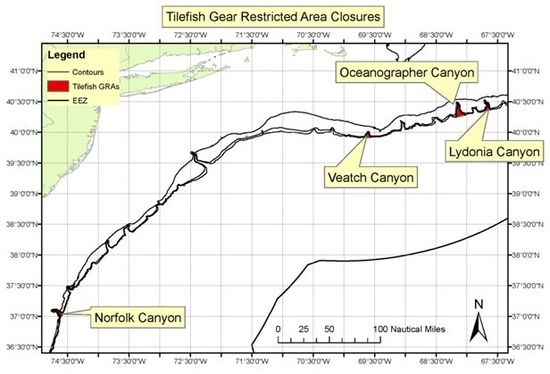
| Lydonia Canyon | Norfolk Canyon | Oceanographer Canyon | Veatch Canyon | ||||
|---|---|---|---|---|---|---|---|
| N Lat. | W Long. | N Lat. | W Long. | N Lat. | W Long. | N Lat. | W Long. |
| 40°31'55.2" | 67°43'1.2" | 37°5'50" | 74°45'34" | 40°29'50" | 68°10'30" | 40°0'40" | 69°37'8" |
| 40°28'52" | 67°38'43" | 37°6'58" | 74°40'48" | 40°29'30" | 68°8'34.8" | 40°41'69" | 69°35'25" |
| 40°21'39.6" | 67°37'4.8" | 37°4'31" | 74°37'46" | 40°25'51.6" | 68°6'36" | 39°54'43" | 69°33'54" |
| 40°21'39.6" | 67°37'4.8" | 37°4'1" | 74°33'50" | 40°22'22.8" | 68°6'50.4" | 39°54'43" | 69°40'52" |
| 40°21'4" | 67°43'1" | 36°58'37" | 74°36'58" | 40°19'40.8" | 68°4'48" | - | - |
| 40°28'31" | 67°43' | 37°4'26" | 74°41'2" | 40°19'5" | 68°2'19" | - | - |
| - | - | - | - | 40°16'41" | 68°1'16" | - | - |
| - | - | - | - | 40°14'28" | 68°11'28" | - | - |
Last updated by NOAA Fisheries on 02/17/2024
Subsistence Fishing Regulations
Last updated by NOAA Fisheries on 02/17/2024
Seafood Facts

Is Tilefish Sustainable?
U.S. wild-caught tilefish is a smart seafood choice because it is sustainably managed and responsibly harvested under U.S. regulations.
Availability
Year-round in the Gulf of Mexico. Can be year-round or seasonal in the South Atlantic and Mid-Atlantic.
Source
U.S. wild-caught from Rhode Island to the west coast of Florida.
Taste
Tilefish has a mild sweet flavor, similar to lobster or crab. It is similar in taste to golden tilefish. Almost all tilefish is sold fresh.
Texture
Firm but tender.
Color
White.
Health Benefits
Tilefish is low in sodium. It is a good source of niacin, phosphorus, protein, vitamin B12, and selenium. More information on health and seafood.
Nutrition Facts
Servings: 1; Serving Weight: 100 g; Calories: 96; Protein: 17.5 g; Total Fat: 2.31 g; Total Saturated Fatty Acids: 0.441 g; Carbohydrate: 0 g; Total Sugars: 0 g; Total Dietary Fiber: 0 g; Cholesterol: 50 mg; Selenium: 36.5 mcg; Sodium: 53 mgMore Information
Last updated by NOAA Fisheries on 02/17/2024
Seafood News
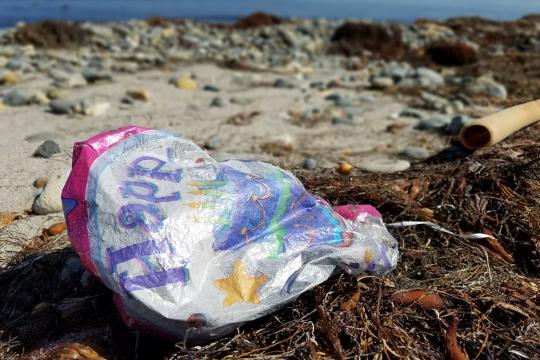 A Mylar balloon on the shoreline of Santa Rosa Island off the coast of California. Credit: Courtesy of NOAA Marine Debris Program
A Mylar balloon on the shoreline of Santa Rosa Island off the coast of California. Credit: Courtesy of NOAA Marine Debris Program
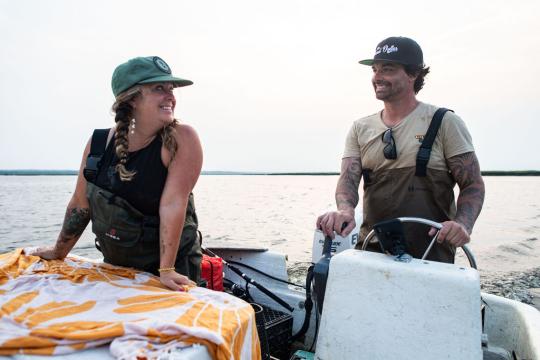 Photo credit: Christine Hochkeppel, christinehochkeppel.com
Photo credit: Christine Hochkeppel, christinehochkeppel.com
 Port of Dutch Harbor and the village of Unalaska in the Aleutian Chain on the edge of the southeastern Bering Sea. Dutch Harbor the largest fishing port by volume in the U.S. Credit: NOAA Fisheries/Paul Hillman.
Port of Dutch Harbor and the village of Unalaska in the Aleutian Chain on the edge of the southeastern Bering Sea. Dutch Harbor the largest fishing port by volume in the U.S. Credit: NOAA Fisheries/Paul Hillman.
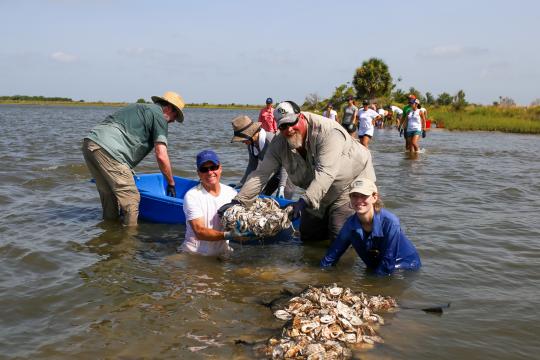 Volunteers build an oyster reef from recycled oyster shells (Photo: Galveston Bay Foundation)
Volunteers build an oyster reef from recycled oyster shells (Photo: Galveston Bay Foundation)
Last updated by NOAA Fisheries on 02/17/2024
Management Overview
The blueline tilefish fishery (north from the Virginia/North Carolina border) is managed by the Mid-Atlantic Fishery Management Council, and NOAA Fisheries implements the regulations.
The fishery is managed using a bag limit for the recreational fishery; and possession limits and a coast-wide quota system for the commercial fishery.
The fishing year runs from January 1 through December 31; with NOAA Fisheries Greater Atlantic Region jurisdiction covering blueline tilefish from Maine to the Virginia/North Carolina border. Tilefish south of this border are managed separately under the Snapper Grouper Complex fishery management plan by the South Atlantic Fishery Management Council. For information on the fishery south of Virginia, contact the Southeast Regional Office at (727) 824-5305.
There are four canyons that have been designated "Tilefish Gear Restricted Areas." These areas are closed to vessels with bottom-tending mobile gear and are described in the tilefish regulations at 50 CFR 648.297. No vessel of the United States may fish with bottom-tending mobile gear (otter trawls, beam trawls, hydraulic dredges, non-hydraulic dredges, and seines) within the restricted areas; which include Lydonia, Norfolk, Oceanographer, and Veatch Canyons.
Management Plans
Specifications and Quotas
The Golden and Blueline Tilefish Fishery Management Plan (FMP) requires the annual specification of catch and harvest limits for up to three years at a time. If specifications are not in place at the start of the fishing year, the existing specifications roll over until new regulations are finalized.
Inseason Actions
If 70 percent of the annual blueline tilefish commercial total allowable landings (TAL) is projected to be landed, the Regional Administrator may reduce the possession limit to 300 lb of gutted blueline tilefish, to prevent overfishing from occurring. Additionally, if 100 percent of the commercial TAL will be fully harvested, then the commercial blueline tilefish fishery will be closed for the remainder of the fishing year.
Current Blueline Tilefish Specifications (January 1 to December 31, 2023)
| Overfishing Limit (OFL) | Unknown |
|---|---|
| Acceptable Biological Catch (ABC) | 100,520 lb |
| Commercial Annual Catch Limit (ACL) | 27,140 lb |
| Recreational ACL | 73,380 lb |
| Commercial Annual Catch Target (ACT) | 27,140 lb |
| Recreational ACT | 73,380 lb |
| Commercial TAL | 26,869 lb |
| Recreational TAL | 71,912 lb |
Accountability Measures
Commercial Accountability Measures
If the commercial ACL is exceeded, the amount of the ACL overage will be deducted from the commercial ACL in the following fishing year. In the event that the commercial ACL has been exceeded and the overage has not been accommodated through the landings-based AM, then the exact amount by which the commercial ACL was exceeded, in pounds, will be deducted, as soon as possible, from the applicable subsequent single fishing year commercial ACL.
Recreational Accountability Measures
If the recreational sector ACL is exceeded, then the exact overage amount, in pounds, will be deducted from the recreational ACL in the following fishing year. Changes to management measures would also be considered through the specifications process to avoid future overages.
Regulatory History
- 2017 - Amendment 6 (Blueline Tilefish Amendment) added blueline tilefish (Caulolatilus microps) as a managed species in the Tilefish Fishery Management Plan; and changing the name of the plan to the Golden and Blueline Tilefish Fishery Management Plan.
- 2018 – Framework 2 implemented several changes intended to improve and simplify the administration of the golden tilefish fishery. These changes include removing an outdated reporting requirement, proscribing allowed gear for the recreational fishery, modifying the commercial incidental possession limit, requiring commercial golden tilefish be landed with the head and fins attached, and revising how assumed discards are accounted for when setting harvest limits.
- 2018 - Framework 4, an omnibus framework, modified the Mid-Atlantic Council's process for setting catch limits.
Last updated by NOAA Fisheries on 02/17/2024
Science Overview
NOAA Fisheries conducts various research activities on the biology, behavior, and population health of blueline tilefish. The results of this research are used to inform management decisions for this species.
For detailed information about stock status, management, assessments, and resource trends, you can search for blueline tilefish, and any other species of interest, using NOAA’s StockSMART web tool.
Researching Blueline Tilefish in the Northeast and Southeast
Blueline tilefish are monitored and assessed by scientists from NOAA’s Southeast Fisheries Science Center through the Southeast Data, Assessment, and Review process.
Last updated by NOAA Fisheries on 02/17/2024
Last updated by NOAA Fisheries on 02/17/2024
